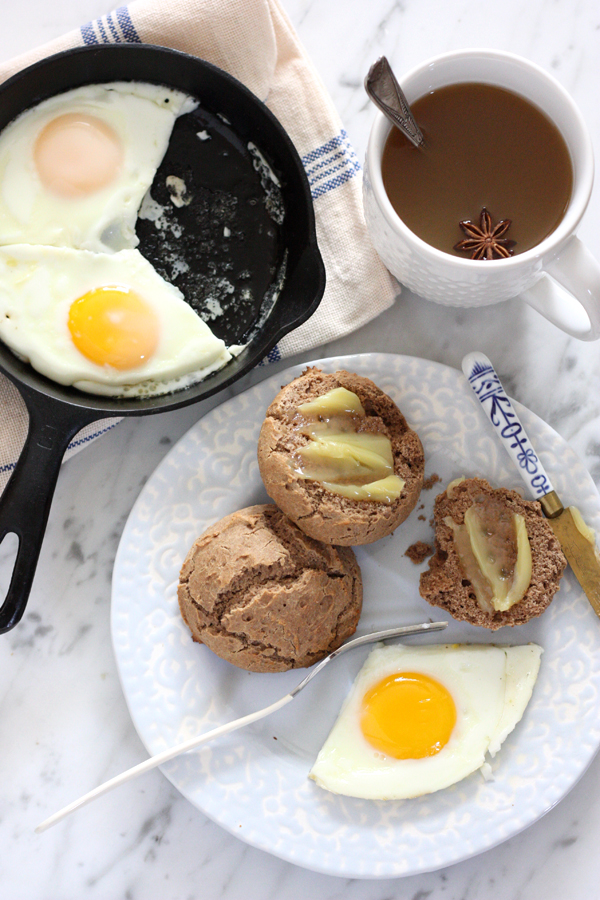
I was recently given a few samples of this Italian chestnut flour. It will be available in Whole Foods beginning November! I’m really excited because I’ve become a big chestnut fan. The main question is, “What does it taste like?!” That’s a really hard question, since I’ve never tasted anything like it before. I guess it tastes nutty, but the flavor is just really foreign to me. What I can tell you is that we all really like the flavor. Also it’s really fine, like powder. It has the texture of arrowroot and tapioca flour, although I don’t think it’s nearly that starchy.
My whole family has been loving these chestnut flour biscuits. I added some arrowroot to tone down the flavor of the chestnut flour (we like the flavor, but it could be a little strong on it’s own), but they might work with all chestnut flour (I haven’t tried yet). Tonight we had them with eggs for an easy dinner. Also, I did some searching, because I thought I remembered my friend Brittany doing some chestnut flour recipes, and she has! So if you’re hungry for more ways to use chestnut flour check it out!
♥, Kelly
American Chestnut history
By Andrew Brozyna
Before the 1900s America’s eastern forests were crowded with chestnut trees. One in every four hardwood trees was an American Chestnut (castanea dentata). They were huge trees, growing to be over 100 feet tall. Chestnut tree wood was a favorite for building (it was naturally rot-resistant), and chestnuts were a favorite nut. Twenty million pounds of chestnuts were harvested each year!
Then in 1876 a nursery in New York imported some Japanese chestnut trees. Tragically, the newly introduced trees brought a deadly fungus. Asian varieties were immune, but in the following decades nearly four billion American chestnuts died from the chestnut blight. In woods today you can still find some resilient old chestnut stumps clinging to life, but the fungus prevents them from growing tall and healthy enough to produce nuts.
In the past thirty years there have been attempts to create a fungus-resistant tree by cross-polinating the American and Asian varieties. In more recent years efforts to revive the American Chestnut have focused on genetic engineering. So we’re not happy to hear about that. There are few nut-producing hybrid chestnut trees in the US today (and the GMO variety does not have federal approval), so there won’t be a substantial local crop any time soon. In the meantime, chestnuts and chestnut flour are imported from Europe (where the fungus is less destructive).
Further reading:
“Background on American chestnut and chestnut blight” on the SUNY College of Environmental Science and Forestry website.
“A New Generation of American Chestnut Trees May Redefine America’s Forests” on the Scientific American website.
American Chestnut: The Life, Death, and Rebirth of a Perfect Tree by Susan Freinkel
Chestnut Flour Biscuits
1 & 1/2 cups chestnut flour
1/2 cup arrowroot flour
1 teaspoon cinnamon
1/4 teaspoon fine sea salt
1/4 teaspoon baking soda
2 eggs
2 tablespoons melted coconut oil
1 tablespoon honey
1/4 cup coconut milk (this is a favorite brand of coconut milk)
- Set the oven to 350 F.
- Combine the dry ingredients with a whisk.
- Add the wet ingredients and combine with an electric mixer.
- Drop the biscuits in 6 piles on a cookie sheet lined with unbleached parchment paper.
- Bake for about 15 minutes.
Makes 6


bob says
I made these today with a couple of ingredient changes to suit my intolerances etc. I think my batter was slightly more wet than yours because they were’t finished by 15 minutes. How would you describe that they were done, Kelly? Springs back? Skewer test?
I have used chestnut flour in things before, but not really as the main flour because of the price. I really like the flavour when it’s paired with cinnamon! It also reminded me a bit of ‘Christmas’, like gingerbread or something. Perhaps hints of ginger or nutmeg flavours in the chestnut flour?
Kelly says
I touch them to see if they move / aren’t done. Maybe yours need a little more flour. I agree, chestnut flour is so suited for Christmas spices!
Lourdes says
Can they only be done with chestnut flour?
Kelly says
I think you could use another nut flour, but I haven’t tested it.
emma bustamate says
I cannot tolerate arrow root or any starch, can i leave it out or what can i use for replacement?
Kelly says
I think it would work with all chestnut, but I haven’t tested it.
Jan says
Awww…. that was my question too (thanks for asking it already, Emma!) OK – so – Kelly, teach us please about this: “this recipe needs starch”…. what does it do in there? Is there really no substitute?? I was so hopeful, especially when you mentioned that chestnut flour “isn’t as starchy”…. I’m another one in the “can’t do starch” boat. Beyond that – LOVE all you do! But teach us please, about this component. Thanks!!
Kelly says
Unfortunately, without starch the biscuits crumble too much. (If this were a wheat recipe then the gluten would hold it all together.)
Adrienne says
Love the Chestnut flour recipe, so nice to see one posted 🙂
Blayne says
Actually Kelly there is an American crop yearly of chestnuts they are hybrid not GMO and they sell about a million pounds a year. However we still import about 40 million pounds. check out http://www.wcga.net/ and also http://www.acf.org/ i have read they have a hybrid that is 90 percent or better the American Chestnut but has the resistance to the blight…. I would encourage everyone to seek out American produced chestnut flour if possibles to encourage more farmers to grow them…
Kelly says
Thanks for the info!
Nancy Cherven says
I make an Italian cookie called Pizzelles with this flour and coconut sugar in a hot Press iron.
They are out of this world deliciouso!